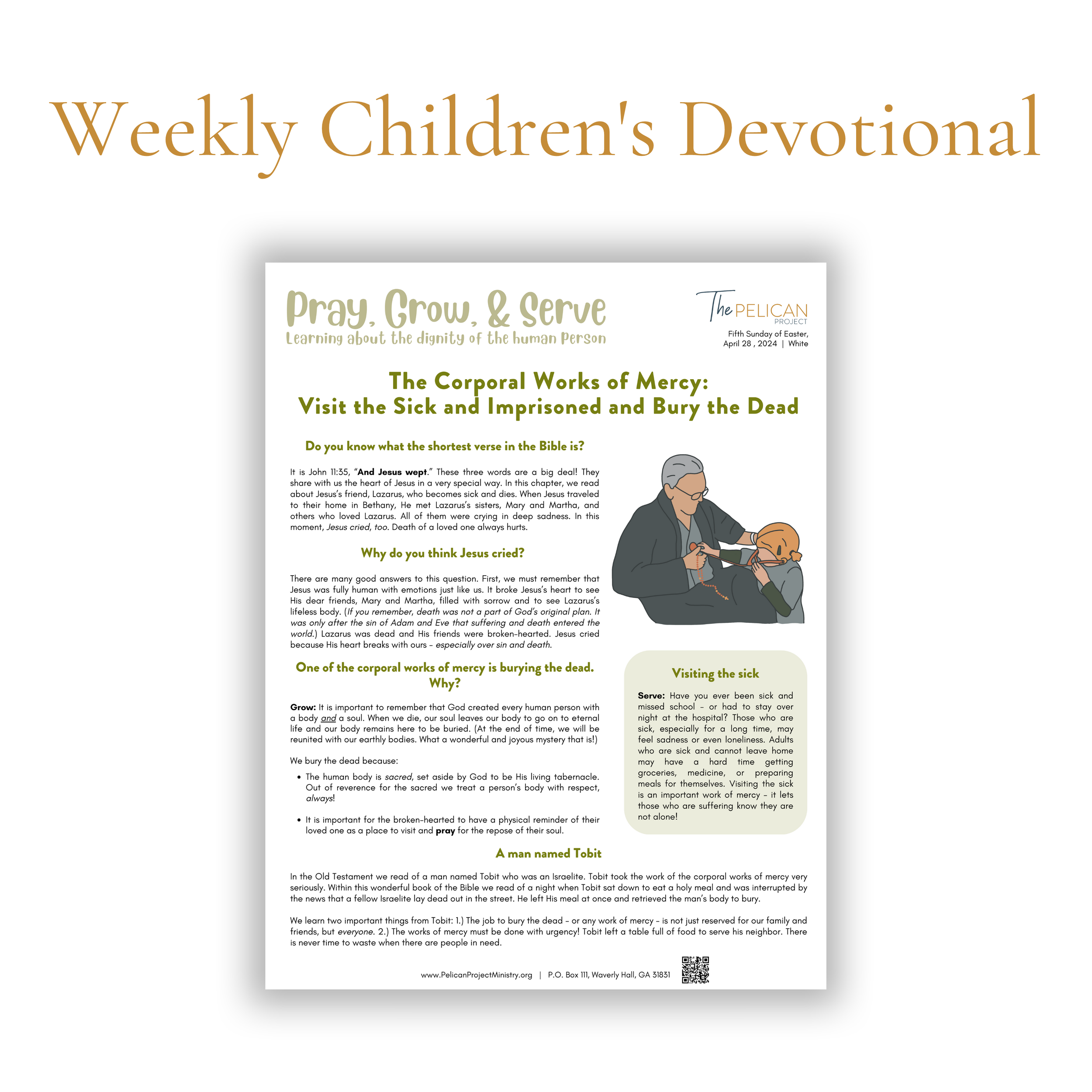burying our dead.
Talking about the Corporal Work of Mercy of burying the dead is an interesting conversation to have with children. Once upon a time, (any Tuesday over cereal), I was sharing with the kids about “faith in action”... the Corporal Works of Mercy came up and before I knew it my son was asking, “So mom, how many bodies do you have buried?”
Hardy, har har. Kids.
It may seem like a point that can be passed over when we’re teaching our children about serving others—Nic’s sarcasm wasn’t too misplaced, how many of us have an experience with burying the dead in the same way we have fed the hungry or donated clothes? It can feel like a one and done conversation – don’t let this happen.
As sure as we will hunger within our lifetime we will die, we will watch loved ones die, we will walk past and through cemeteries, we will stop in traffic for funeral processions and send flowers to funeral homes for those we mourn….
The reality is, how we treat the dead mirrors how we treat the living—a human person has an eternal dignity as he/she was created in the image and likeness of God.
We have received many questions on how (and why!) we honor the dignity of the human person in death. Here are two that we get most often!
Why do we bury the dead? (As shared in this week’s PGS)
God created every human person with a body and a soul. When we die, our soul leaves our body to go on to eternal life and our body remains here to be buried. At the end of time, we will be reunited with our earthly bodies. (Don’t shy from this incredible reality, proclaim it from the rooftops for the wonderful and joyous mystery that is!) With this truth in mind, our body should never be objectified or discarded!
The human body is sacred, set aside by God to be His living tabernacle. Out of reverence for the sacred we treat a person’s body with respect, always!
It is important for the broken-hearted to have a physical reminder of their loved one as a place to visit and pray for the repose of their soul.
Is Cremation allowed in the Catholic Church?
Cremation has been prohibited by the Catholic Church for a very long time; however, in 1963 the Vatican allowed cremation for various reasons—sanitation, financial constraint, overcrowding of cemeteries, etc… This was a pastoral allowance to remove undue hardship from families who had significant hurdles in burying loved ones. (Many times we think about these allowances as Americans or Westerners—but this allowance has the entire world’s Catholic population in mind. My mind immediately thinks of Vietnamese Catholics or the decolonization of much of Africa in the 60’s—money, land, and infrastructure in these spaces were unstable during this time. Perhaps this was on the mind of the Holy See… Just speculating, but I think it’s a reasonable point to consider!)
The Vatican was clear to say that cremation in no way affects the final resurrection of the body nor takes away from the dignity of the human person if the cremation is done for the above reasons and it is done within the framework of a Catholic funeral and burial of ashes in a sacred space—i.e. cemetery. This “fence” around how cremation was to be done was of course to maintain the dignity of the human person.
Can you choose to keep the ashes of a loved one rather than bury them?
It is easy to understand the heart behind keeping the ashes of a loved one, but the reality is, that it doesn’t honor the deceased nor the living faithful. A good Father gives careful boundaries to keep His children from making choices that could hurt them. Because of this, the Church desires to honor the dignity of the human body by ensuring it rests in a sacred space until the end of time. The Church strives to ensure that the dead are still a part of the daily prayers of the Body of Christ—not forgotten, prayed for, hopefully saints! This happens best when the dead are buried in a sacred space. In addition, our earthly death is birth-day into eternal life - scattering ashes seems to take away from the great forever our body and soul is destined for!
How is separating ashes from cremation different from separating relics from a saint's body?
First-class bodily relics (at least now) are reverently taken from the body of a saint for veneration. They are treated with respect, stored in a sacred/blessed space, and they inspire the faithful to conform their own hearts to Christ. Their purpose is to lead the faithful in an ascent of faith… Their separation from their buried body is done with a purpose that is approved by our Mother, the Church, for the greater good of the faithful with the full dignity of their person in mind. In other words, the desire to place a loved one’s ashes on a mantel while it sits before a TV with Judge Judy gathering dust doesn't honor the Communion of Saints, the necessity to offer reparation for the dead or move the hearts of the living faithful to gaze toward heaven.
Please talk with your children about corporal works of mercy. They aren’t a community service “to-do” list; they are non-negotiable for the daily Christian life, which allows us to honor the dignity of our neighbor and serve as Christ’s hands and feet while inviting them to His heart. Download our Pray, Grow, and Serve below to help you in this conversation with your kiddos!


